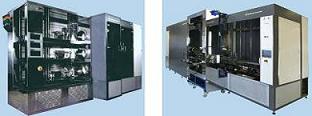Diffusion
Diffusion
and
ion implant
are the two major processes by which chemical species or
dopants
are introduced into a semiconductor such as silicon to form the
electronic structures that make integrated circuits useful (although ion
implant is now much more widely used for this purpose than thermal
diffusion).
Diffusion is the
movement of a chemical species from an area of
high concentration to an
area of
lower
concentration. The controlled diffusion of dopants into silicon,
which is accomplished using a diffusion furnace, is the foundation of forming a p-n junction and
fabrication of devices during wafer fabrication.
 |
|
Fig.
1.
Examples of
Diffusion Furnaces |
Diffusion is used primarily
to alter the
type
and level
of
conductivity
of semiconductor materials.
It is used to form bases, emitters, and resistors in bipolar devices, as
well as drains and sources in MOS devices. It is also used to dope
polysilicon
layers.
The
mathematics of diffusion are based on
Fick's laws.
If there is a chemical concentration gradient in a finite volume of
silicon (or any matrix substance for that matter), the impurity material
will tend to move such that the
concentration gradient is
decreased. If the
flow is sustained for a sufficient amount of time, the substance will
become homogeneous and diffusion will cease.
Fick's First Law
is an equation describing the flow of an impurity in a substance,
showing that the
flux
of material across a given plane is
proportional
to the
concentration
gradient
across the plane.
More
frequently, however, Fick's First Law is not an adequate description of
the diffusion process since the
concentration
gradient
of an impurity in a finite volume of material
decreases
with time.
Fick's Second Law
describes this phenomenon. The solution to Fick's Second Law
depends greatly on the method by which the impurities are supplied to
the substrate.
There are two
major ways by which to deposit impurities into a substance by
thermal
diffusion.
In the first method, known as
predeposition,
a flux of impurities continuously arrives at the surface of the
substrate such that the concentration gradient of the impurity remains
constant at the surface of the substrate. In the second method,
known as
redistribution
or
drive-in
diffusion, a thin layer of the impurity material is deposited on
the substrate. In this case, the impurity gradient at the surface
of the substrate decreases with time.
Wafer Fab
Links:
Incoming
Wafers;
Epitaxy;
Diffusion;
Ion
Implant;
Polysilicon;
Dielectric;
Lithography/Etch;
Thin
Films;
Metallization;
Glassivation;
Probe/Trim
See Also:
Fick's Laws;
IC
Manufacturing; Wafer Fab Equipment
HOME
Copyright
©
2001-2006
www.EESemi.com.
All Rights Reserved.

